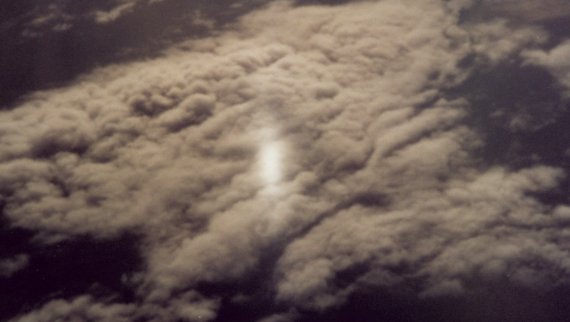SKYLIGHTS

Photo of the Week.. Sunlight reflected from ice
crystals in clouds create a billiant "subsun."
Astronomy news for the week starting Friday, February 15, 2002.
The Moon grows through its crescent phase the early part of the
week, and reaches its first quarter on Wednesday the 20th well
after moonset for the Americas, the closest view to the actual
quarter taking place the night of Tuesday, the 19th. Look for a
nice configuration with bright Mars the night of Saturday, the
16th, the crescent Moon passing five degrees to the south of the
red planet. Mars is practically on the ecliptic (the apparent path
of the Sun), while the Moon will be about as far south of the
ecliptic as it can get.
The real match-up of the week, however, involves the Moon and
Saturn, as the ringed planet takes a direct hit the night of
Wednesday the 20th, the Moon just past the quarter, which means
that Saturn will disappear suddenly behind the nighttime leading
eastern lunar edge. The times of the occultation vary across the
continent. The event is best viewed in the east, where it takes
place in full darkness. The west coast unfortunately loses out as
Saturn is covered during daylight. In New York and Chicago, Saturn
respectively disappears at 7:25 and 6:05 PM local time (the latter
in twilight), and reappears at 8:43 and 7:14. The central path of
the occultation lies more to the south, however. In Atlanta, the
times are 6:55 and 8:26, while in Dallas they are 5:30 and 6:56.
While lunar occultations of planets are pretty, they are of little
professional interest. Those of stars, on the other hand, are
avidly observed, as we can use them to determine stellar diameters,
and even the presence of close companions.
Even if you miss the occultation, the juxtaposition of Saturn with
Taurus's Hyades is always well worth a look. Some 30 degrees to
the east of the Saturn shines brilliant Jupiter, which is nicely
set into Gemini. With Saturn
moving to the east against the background stars and Jupiter still
moving slowly westerly, the two planets draw ever so slightly
closer together, a situation that will not last, as Jupiter will
reverse itself about the end of the month.
Little Mercury, which has been in hiding for some time now, makes
an early morning appearance, though because of the flat angle of
the ecliptic to the horizon, not a very good one. The little
planet reaches maximum western elongation relative to the Sun the
morning of Thursday, the 21st.
Cassiopeia and Ursa Major, with their prominent respective "W" and Big Dipper, circle the north
celestial pole like opposing hands on a giant clock. As Cassiopeia
now descends into the northwestern sky, watch for the rising of the
Dipper, which in mid-evening magnificently stands upon its bright
handle. To the south in early evening shine the winter stars,
dominated by wonderful Orion, the
Hunter, the bright constellation surrounded by his grand retinue.







